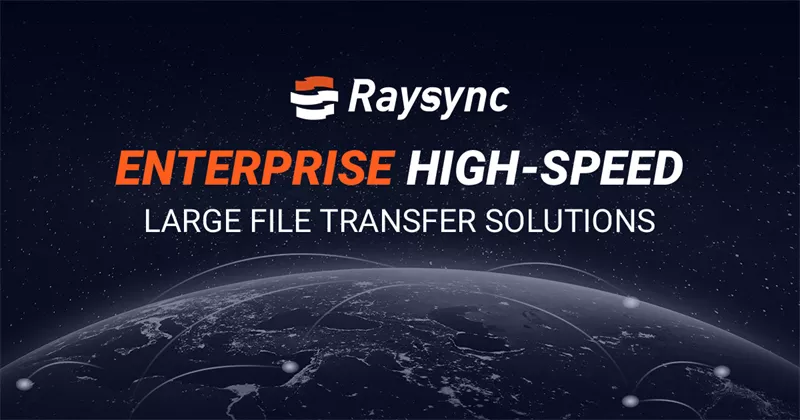Full List of 6 Managed File Transfer Protocols
This article aims to demystify the landscape by providing a comprehensive comparison of six key Managed File Transfer protocols, offering beginners a clear understanding of their features, functionalities, and suitability for various use cases.

As we delve into each MFT file transfer protocol, we'll explore their strengths, weaknesses, and practical applications, empowering beginners to make informed decisions tailored to their specific needs.
Does a Managed File Transfer Protocol Exist
No, it doesn't. Rather than a single, universal protocol, MFT refers to a concept encompassing various methods and technologies aimed at facilitating secure and efficient file transfers.
These protocols include FTP, SFTP, OFTP, FPTS, HTTPS, and others, each offering unique features and capabilities.
While there isn't a one-size-fits-all solution, the essence of MFT file transfer protocol lies in their integration within a centralized, managed framework.
By employing a combination of protocols and technologies, organizations can achieve a cohesive and streamlined approach to file transfers, ensuring compliance, security, and operational efficiency across their data exchange processes.
6 Essential File Transfer Protocols for Managed File Transfer
In the realm of Managed File Transfer (MFT), selecting the right MFT file transfer protocol is crucial for ensuring secure and efficient data exchange.
Here, we outline six essential file transfer protocols vital for MFT operations, each offering distinct features and capabilities to address various transfer requirements and security considerations.
FTP
FTP, an essential component of file transfer protocols, facilitates the basic transfer of files over networks. Despite its ubiquity, FTP's absence of encryption leaves it susceptible to security vulnerabilities, compelling organizations to seek more robust alternatives like SFTP.
Pros:
- Widely Used: FTP is a well-established MFT file transfer protocol, supported by virtually all operating systems and many applications.
- Simple to Implement: FTP is straightforward to set up and use, making it accessible for users with varying levels of technical expertise.
Cons:
- Lack of Security: FTP transfers data in plain text, making it vulnerable to interception, eavesdropping, and other security threats.
- No Built-in Encryption: Without built-in encryption, FTP exposes sensitive data during transit, which can lead to data breaches.
SFTP (SSH File Transfer Protocol)
SFTP, or SSH is a MFT transfer protocol, significantly bolsters security by integrating encryption into the file transfer process, thereby guaranteeing the confidentiality and integrity of data during transmission over SSH connections. Renowned for its formidable security attributes, SFTP stands out as a preferred choice for securely transferring sensitive data.
Pros:
- Enhanced Security: SFTP uses SSH for encryption, providing a secure channel for data transfer and protecting data from interception and unauthorized access.
- Data Integrity: The protocol ensures data integrity by validating that the data received matches the data sent, reducing the risk of data corruption.
Cons:
- Performance Overhead: The encryption and decryption processes can introduce performance overhead, potentially slowing down file transfers compared to unencrypted protocols.
- Complexity: Setting up SFTP can be more complex than FTP, requiring familiarity with SSH and key management.
OFTP
OFTP, the Odette File Transfer Protocol, is meticulously crafted to meet the intricate demands of the automotive sector. It provides standardized messaging formats and robust security measures, making it an optimal choice for facilitating seamless data exchange within automotive supply chains.
Pros:
- Standardization: OFTP offers standardized messaging formats, ensuring consistent and reliable communication between different entities within the automotive industry.
- Efficiency: OFTP streamlines communication processes, enhancing operational efficiency and reducing the risk of errors in data exchange.
Cons:
- Complex Setup: Implementing OFTP can be complex and may require specialized knowledge and resources to ensure proper configuration and maintenance.
- Cost: The need for dedicated infrastructure and expensive software licenses can lead to higher costs compared to more generic file transfer MFT transfer protocol.
- Limited Use Case: While ideal for the automotive industry, OFTP's specialized nature makes it less suitable for industries with different requirements.
FTPS
FTPS, or File Transfer Protocol Secure, seamlessly integrates the ease of use of FTP with the robust security mechanisms of SSH. By blending these features, FPTS enables secure file transfers over the internet, safeguarding data confidentiality and integrity throughout the transmission process.
Pros:
- Enhanced Security: Combines the ease of FTP with the security of SSH, encrypting data to ensure confidentiality and integrity during transmission.
- Data Protection: Protects against unauthorized access and interception, addressing the security vulnerabilities of unencrypted file transfers.
Cons:
- Performance Overhead: The encryption process can introduce additional processing overhead, potentially impacting transfer speeds compared to unencrypted FTP.
- Complexity: May require more complex setup and configuration compared to standard FTP, particularly for users unfamiliar with SSH.
HTTPS
HTTPS, or Hypertext Transfer Protocol Secure is extensively employed for transmitting sensitive data, guaranteeing the confidentiality and integrity of information exchanged between clients and servers. Its widespread adoption across web platforms and applications underscores its reliability and efficacy in safeguarding data against unauthorized access or interception.
Pros:
- Widespread Adoption: Universally supported by web browsers and applications, making it a standard for secure internet communication.
- Data Protection: Prevents unauthorized access and data breaches by encrypting information exchanged between clients and servers.
Cons:
- Certificate Management: Requires the management and periodic renewal of SSL/TLS certificates, which can be complex and time-consuming.
- Cost: Obtaining SSL/TLS certificates may involve costs, particularly for higher levels of validation (such as Extended Validation certificates).
Raysync UDP Transfer Protocol
Raysync UDP Transfer Protocol stands out for its unparalleled combination of high-speed data transmission and robust security features. Designed to meet the demands of transferring large files and managing data-intensive workflows, this MFT transfer protocol excels in ensuring maximum file transfer efficiency, even in challenging network conditions.
Pros:
- Unmatched Speed: Leveraging UDP technology, Raysync achieves data transmission speeds up to 100 times faster than traditional protocols like FTP/HTTP, dramatically reducing transfer times for large files.
- Superior Efficiency: Optimizes bandwidth utilization to ensure efficient data transfers, even in environments with high latency and packet loss, making it ideal for long-distance transfers.
- Robust Security: Employs AES-256 and TLS encryption to protect data during transfer, ensuring both confidentiality and integrity.
Cons:
- Initial Setup: While user-friendly, initial deployment and integration might require technical expertise for optimizing performance and security settings.
- Cost: Advanced features and exceptionally amazing scalability options come at a bit of a higher price point, potentially impacting budget considerations for smaller organizations.
By excelling in speed, security, and scalability, Raysync UDP Transfer Protocol sets a high standard for managed file transfer solutions, making it the go-to choice for enterprises looking to enhance their data transfer capabilities.
Other Non-Transfer Protocols Related to MFT Protocol
MFT protocols handle the secure transfer of files, but other protocols play a supporting role.
These non-transfer protocols provide functionalities like secure access (SSH), secure EDI communication (AS1-4), and industry-specific data exchange (RosettaNet).
Their integration with MFT software creates a comprehensive solution for secure and automated file transfers.
- Secure Shell (SSH): This protocol provides secure access to remote machines. MFT software can leverage SSH for secure authentication and file transfer over SFTP (Secure File Transfer Protocol).
- AS1, AS2, AS3, and AS4: These are application-level protocols specifically designed for secure EDI (Electronic Data Interchange) communication. MFT software can integrate with these protocols to facilitate automated and secure exchange of business documents between organizations.
- Secure Email: While not a core MFT protocol, secure email functionalities can be integrated with MFT solutions. This allows for sending and receiving encrypted emails containing files, offering an alternative for scenarios where traditional file transfer methods are not suitable.
- RosettaNet: This is an industry-specific protocol suite designed for data exchange in the manufacturing sector. MFT software can support RosettaNet to ensure secure and reliable file transfers within this specific domain.
The Best Managed File Transfer Alternative - Raysync
Raysync stands out as the premier managed file transfer alternative, offering a comprehensive solution that addresses the shortcomings of traditional methods while delivering unparalleled speed, security, and scalability.

As organizations grapple with the need to transfer large volumes of data quickly and securely, Raysync emerges as a beacon of innovation in the file transfer landscape.
Its proprietary MFT transfer protocol enables lightning-fast transfer speeds, up to 100 times faster than traditional FTP/HTTP methods, optimizing bandwidth utilization and ensuring swift data transfers regardless of file size or network conditions.
Some of the core features of Raysync are:
- Ultra-Fast Transfer Speeds: Raysync's proprietary protocol enables data transfer speeds up to 100 times faster than traditional FTP/HTTP methods.
- Robust Security: AES-256 Encryption: Ensures data confidentiality with bank-level encryption.
- Scalability and Flexibility: Unlimited Transfer Volume: Supports transferring unlimited amounts of data without performance degradation.
- Ease of Use: User-Friendly Interface: Intuitive design for easy operation and management.
- Cost-Efficiency: Affordable Pricing Plans: Provides cost-effective solutions suitable for businesses of all sizes, from small teams to large enterprises.
The Bottom Line
As organizations navigate the complexities of file transfers, selecting the right MFT transfer protocol is paramount to ensure efficiency, security, and compliance.
Here we strongly suggest Raysync for enterprises. By utilizing the power of Raysync, businesses can enhance productivity, and mitigate risks associated with data breaches or compliance violations.
You might also like

Industry news
May 27, 20246 MFT Services for Enterprise: Streamline Your Secure File Transfers
In this article, we will be studying mft services and will give an insight to our readers about the best mft services that you can use.

Industry news
August 16, 2022What's the best way for organizations to manage data efficiently?
How to solve the problem of efficiently managing data is a data problem faced by small and medium enterprises at present, and it is very important to the future development direction of the company.

Industry news
June 29, 2022What are the Reasons Why Big Data does Not Work?
How can big data technology bring success to the enterprise in the grand plan of things? It turns out that it is not as good as hope. Optimistic expectations for big data may exceed our ability to actually execute comprehensive big data correctly.